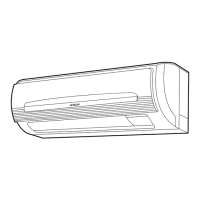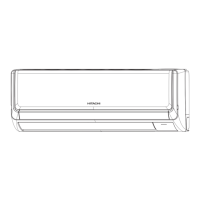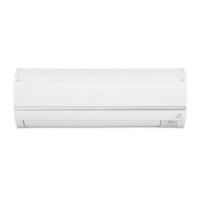Do you have a question about the Hitachi RAS-10C9 and is the answer not in the manual?
Identifies specific indoor/outdoor unit models for the air conditioner.
Covers safety measures and warnings related to the installation process of the air conditioner unit.
Outlines safety guidelines to follow when moving or maintaining the air conditioner.
Details essential safety instructions to observe while operating the air conditioner.
Details the components and their functions within the indoor air conditioner unit.
Describes the components and functions of the outdoor unit of the air conditioner.
Lists the available models along with their physical dimensions for reference.
Explains the function of the operation, timer, and filter indicator lamps on the indoor unit.
Describes the function of the auto restart switch for power failure recovery and timer operations.
Details how to use the temporary switch for starting/stopping operation when the remote is unavailable.
Explains the purpose and operation of each button on the remote control unit.
Provides important advice and warnings for using the remote control unit correctly.
Guides on how to start and adjust settings for automatic operation mode.
Details the conditions for cool and dehumidify modes based on room temperature and fan speed.
Explains how to use the circulation mode, especially for heating distribution.
Provides instructions on how to set and cancel the sleep timer function for automatic shutdown.
Guides on selecting cooling, dehumidify, or circulation modes and setting room temperature.
Explains how to adjust fan speed for different operation modes.
Describes the specific behavior and operation of the dehumidify function.
Instructions for setting the timer to turn the unit off automatically.
Instructions for setting the timer to turn the unit on automatically.
How to cancel any previously set timer reservations.
Explains how to adjust the horizontal deflector for vertical airflow direction.
Describes how to adjust the vertical deflector for horizontal airflow direction.
Step-by-step guide on how to replace the batteries in the remote control unit.
Important warnings regarding the use and handling of batteries for the remote control.
Guidance on setting optimal temperatures for comfort and specific user groups.
Tips for ventilation and using window coverings to manage room conditions.
Recommendations for using the timer function to optimize comfort and energy saving.
Emphasizes the importance of regular air filter cleaning for performance.
Explains how internal heat sources affect the air conditioner's cooling performance.
Instructions for handling the unit when it will not be used for an extended period.
Safety measures to take during lightning storms to protect the unit.
Advice on preventing interference between the AC unit and other electrical products.
Step-by-step guide on how to attach the air cleansing and deodorizing filters.
Important notes regarding the use, performance impact, and care of Nano Titanium filters.
Detailed procedure for cleaning the air filter, including steps and precautions.
Warnings about washing methods, detergents, and drying the air filters.
Instructions for cleaning the front panel of the indoor unit and the remote controller.
Procedure for preparing the unit for extended periods of non-use.
Checklist for semi-annual or yearly inspections of the unit and its installation.
Crucial information on wire coloring, grounding, and circuit breakers for electrical safety.
Points to check before requesting service for non-operation or poor cooling.
Explains normal operational sounds and how to manage odors.
Provides recommended indoor and outdoor operating temperature ranges for cooling.
Identifies specific indoor/outdoor unit models for the air conditioner.
Covers safety measures and warnings related to the installation process of the air conditioner unit.
Outlines safety guidelines to follow when moving or maintaining the air conditioner.
Details essential safety instructions to observe while operating the air conditioner.
Details the components and their functions within the indoor air conditioner unit.
Describes the components and functions of the outdoor unit of the air conditioner.
Lists the available models along with their physical dimensions for reference.
Explains the function of the operation, timer, and filter indicator lamps on the indoor unit.
Describes the function of the auto restart switch for power failure recovery and timer operations.
Details how to use the temporary switch for starting/stopping operation when the remote is unavailable.
Explains the purpose and operation of each button on the remote control unit.
Provides important advice and warnings for using the remote control unit correctly.
Guides on how to start and adjust settings for automatic operation mode.
Details the conditions for cool and dehumidify modes based on room temperature and fan speed.
Explains how to use the circulation mode, especially for heating distribution.
Provides instructions on how to set and cancel the sleep timer function for automatic shutdown.
Guides on selecting cooling, dehumidify, or circulation modes and setting room temperature.
Explains how to adjust fan speed for different operation modes.
Describes the specific behavior and operation of the dehumidify function.
Instructions for setting the timer to turn the unit off automatically.
Instructions for setting the timer to turn the unit on automatically.
How to cancel any previously set timer reservations.
Explains how to adjust the horizontal deflector for vertical airflow direction.
Describes how to adjust the vertical deflector for horizontal airflow direction.
Step-by-step guide on how to replace the batteries in the remote control unit.
Important warnings regarding the use and handling of batteries for the remote control.
Guidance on setting optimal temperatures for comfort and specific user groups.
Tips for ventilation and using window coverings to manage room conditions.
Recommendations for using the timer function to optimize comfort and energy saving.
Emphasizes the importance of regular air filter cleaning for performance.
Explains how internal heat sources affect the air conditioner's cooling performance.
Instructions for handling the unit when it will not be used for an extended period.
Safety measures to take during lightning storms to protect the unit.
Advice on preventing interference between the AC unit and other electrical products.
Step-by-step guide on how to attach the air cleansing and deodorizing filters.
Important notes regarding the use, performance impact, and care of Nano Titanium filters.
Detailed procedure for cleaning the air filter, including steps and precautions.
Warnings about washing methods, detergents, and drying the air filters.
Instructions for cleaning the front panel of the indoor unit and the remote controller.
Procedure for preparing the unit for extended periods of non-use.
Checklist for semi-annual or yearly inspections of the unit and its installation.
Crucial information on wire coloring, grounding, and circuit breakers for electrical safety.
Points to check before requesting service for non-operation or poor cooling.
Explains normal operational sounds and how to manage odors.
Provides recommended indoor and outdoor operating temperature ranges for cooling.
| Cooling Capacity | 2.5 kW |
|---|---|
| Heating Capacity | 3.2 kW |
| Energy Efficiency Ratio (EER) | 3.21 |
| Refrigerant | R410A |
| Weight (Indoor Unit) | 9 kg |
| Weight (Outdoor Unit) | 28 kg |
| Coefficient of Performance (COP) | 3.61 |
| Noise Level (Outdoor) | 50 dB |
| Type | Split |
| Power Supply | 220-240 V, 50 Hz |












